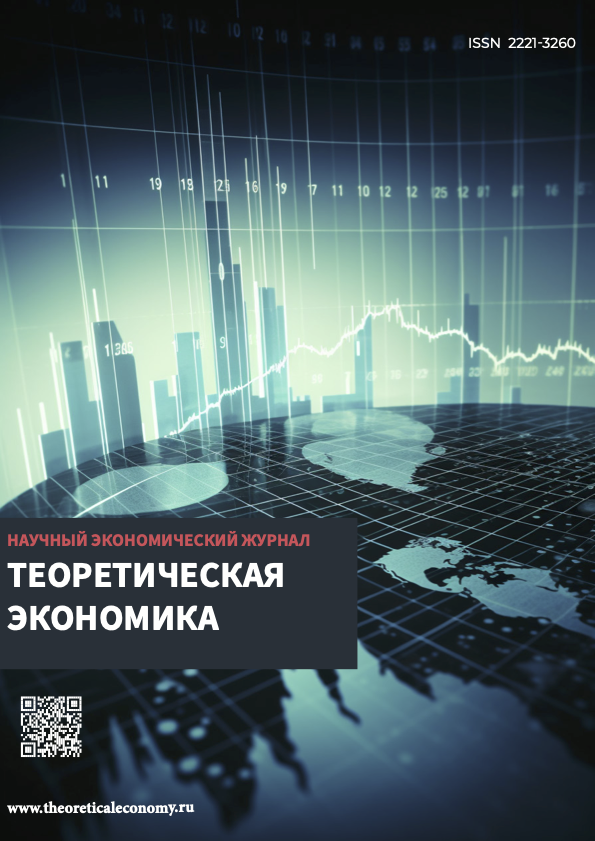Ярославль, Россия
Актуальность исследования обусловлена тем, что размер и роль российской экономики среди государствачленов ЕАЭС, а также масштаб текущих политических и экономических вызовов, делают ее главным генератором негативных экономических процессов на пространстве Союза. Понимание спилловер-эффектов, возникающих в процессе интеграции будет способствовать сокращению негативных внешних экономических шоков на пространстве ЕАЭС. Цель статьи – идентифицировать спилловер-эффекты в экономической литературе в логике развития интеграционных процессов. В обзоре литературы анализируются актуальные источники, связанные с экономическим контекстом спилловерэффектов. В данной статье представлена вторая часть обзора литературы, позволяющая идентифицировать спилловерэффекты, возникающие в процессе интеграции рынков, стран и отдельных регионов в экономической литературе. В результате проведенного исследования установлено, что в экономической литературе сложился определенный консенсус в понимании спилловер-эффектов прежде всего в аспекте интеграции финансовых и ресурсных рынков.
спилловер-эффекты, обзор литературы, интеграция, финансовые рынки, распространение кризисных явлений.
1. Шкиотов, С.В. и Маркин, М.И. (2023). Анализ спилловер-эффектов в экономической литературе. Теоретическая экономика, 104(8), 76-86. URL: http://theoreticaleconomy.ru/index.php/tor/article/ view/465
2. Ma, X., Zou, D., Huang, C., & Lv, S. (2020). China’s growing influence and risk in Asia–Pacific stock markets: evidence from spillover effects and market integration. Risk Management, 22(4), 338–361. https:// doi.org/10.1057/s41283-020-00065-0
3. Hung, N. T. (2020). An analysis of CEE equity market integration and their volatility spillover effects. European Journal of Management and Business Economics, 29(1), 23–40. https://doi.org/10.1108/EJMBE-01-2019-0007
4. Hafner, K. A. (2014). Technology spillover effects and economic integration: evidence from integrating EU countries. Applied Economics, 46(25), 3021–3036. https://doi.org/10.1080/00036846.2014.920479
5. Camera, G., Hohl, L., & Weder, R. (2023). Inequality as a barrier to economic integration? An experiment. Experimental Economics, 26(2), 383–411. https://doi.org/10.1007/s10683-022-09777-4
6. Mata, M. N., Razali, M. N., Bentes, S. R., & Vieira, I. (2021). Volatility spillover effect of pan-asia’s property portfolio markets. Mathematics, 9(12). https://doi.org/10.3390/math9121418
7. Habiba, U. E., Peilong, S., Zhang, W., & Hamid, K. (2020). International stock markets Integration and dynamics of volatility spillover between the USA and South Asian markets: evidence from Global financial crisis. Journal of Asia Business Studies, 14(5), 779–794. https://doi.org/10.1108/JABS-03-2019-0071
8. Liu, J., Hu, Y., Yan, L. Z., & Chang, C. P. (2023). Volatility spillover and hedging strategies between the European carbon emissions and energy markets. Energy Strategy Reviews, 46. https://doi.org/10.1016/j. esr.2023.101058
9. Nawaz, S., & Mangla, I. U. (2021). The economic geography of infrastructure in Asia: The role of institutions and regional integration. Research in Transportation Economics, 88. https://doi.org/10.1016/j. retrec.2021.101061
10. Zhang, P., Sha, Y., & Xu, Y. (2021). Stock Market Volatility Spillovers in G7 and BRIC. Emerging Markets Finance and Trade, 57(7), 2107–2119. https://doi.org/10.1080/1540496X.2021.1908256
11. Georgiadis, G. (2016). Determinants of global spillovers from US monetary policy. Journal of International Money and Finance, 67, 41–61. https://doi.org/10.1016/j.jimonfin.2015.06.010
12. Arin, K. P., Caporale, G. M., Kyriacou, K., & Spagnolo, N. (2020). Financial Integration in the GCC Region: Market Size Versus National Effects. Open Economies Review, 31(2), 309–316. https://doi. org/10.1007/s11079-019-09554-6
13. Kemme, D. M., Akhmetzaki, Y., & Mukhamediyev, B. M. (2021). The effects of the Eurasian Economic Union on regional foreign direct investment and implications for growth. Journal of International Trade and Economic Development, 30(5), 643–660. https://doi.org/10.1080/09638199.2021.1896769
14. Likhacheva, A. (2021). Russia and Sanctions: The Transformational Domestic and International Effects of Unilateral Restrictive Measures. Russian Politics, 6(4), 478–502. https://doi.org/10.30965/24518921-00604005
15. Mukhamediyev, B. M., & Spankulova, L. S. (2022). Mutual Influence of Innovation and Human Capital on Regional Growth in Neighboring Countries: The Case of Russia and Kazakhstan. Regional Research of Russia, 12(3), 350–364. https://doi.org/10.1134/S2079970522700216
16. Osório, A., & Pinto, A. (2020). Income inequality and technological progress: The effect of R&D incentives, integration, and spillovers. Journal of Public Economic Theory, 22(6), 1943–1964. https://doi. org/10.1111/jpet.12466
17. Wang, M. C., & Shih, F. M. (2013). Time-varying world and regional integration in emerging european equity markets. European Financial Management, 19(4), 703–729. https://doi.org/10.1111/j.1468-036X.2011.00623.x
18. Fukuda, Y., Kimura, Y., Sudo, N., & Ugai, H. (2013). Cross-country Transmission Effect of the U.S. Monetary Shock under Global Integration. Bank of Japan Working Paper Series, 13(16).
19. Dine, M. N. (2019). Impact of global value chains’ participation on employment in Turkey and spillovers effects. Journal of Economic Integration, 34(2), 308–326. https://doi.org/10.11130/jei.2019.34.2.308
20. Law, C. H., Tee, C. L., & Lau, W. T. (2019). The Impacts of Financial Integration on the Linkages Between Monetary Independence and Foreign Exchange Reserves. International Economic Journal, 33(2), 212–235. https://doi.org/10.1080/10168737.2019.1587488
21. Qarni, M. O., & Gulzar, S. (2018). Return and Volatility Spillover across stock markets of China and its Major Trading Partners: Evidence from Shanghai Stock Exchange Crash. Business & Economic Review, 10(3), 1–20. https://doi.org/10.22547/ber/10.3.1
22. Darfo-Oduro, R. K. A., & Stejskal, J. (2022). FDI Spillover Channel and its Effect on Innovation. European Conference on Knowledge Management, 23(1), 289–296. https://doi.org/10.34190/eckm.23.1.328
23. Goczek, Ł., & Witkowski, B. (2023). Spillover effects of the unconventional monetary policy of the European Central Bank. Quarterly Review of Economics and Finance, 89, 82–104. https://doi.org/10.1016/j. qref.2023.02.003
 Контент доступен под лицензией Creative Commons Attribution-NonCommercial-NoDerivatives 4.0 International
Контент доступен под лицензией Creative Commons Attribution-NonCommercial-NoDerivatives 4.0 International











